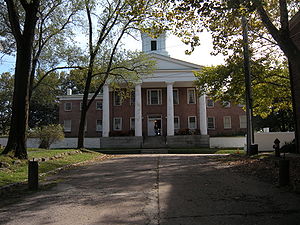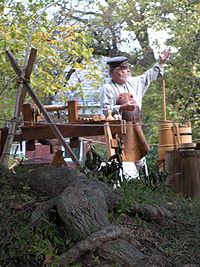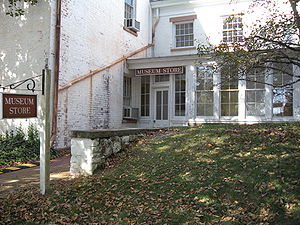User:Kaitlin.KellyFrom The Peopling of New York City
PRESERVING STATEN ISLAND: THERE'S MORE TO IT THAN YOU THINKPreserving the Past - The Ongoing ProcessOften forgotten and isolated from the city, Staten Island may be small but has a great heart for the preservation of history. Staten Island historical sites define the island’s past, present, and future. There are many organizations that contribute to maintaining Staten Island’s past. The Preservation League of Staten Island (PLSI) was started in 1977 with the mission to “enrich Staten Island’s sense of community by promoting and advocating the conservation of its diverse and significant historic built environment and cultural landscapes.”1They have been very successful in past few years. One of their projects was getting the Lighthouse Service Center near the St. George Ferry Terminal landmarked which has been used lighthouse supply for many years. They are also recently in the process of trying to get the old clinic in Castleton a landmark. Chan Graham, Consultant for the PlSI, believes we can learn from our past and thinks the historical sites on Stat en Island are successful in getting people to care. To support this statement he mentioned that the PLSI offers an award program to people who restore houses. Another aspect the PLSI considers is “adaptive reuse.” “This is an important part of preservation,” said Chan. The clubhouse at LaTourette Golf, the Alice Austen House, the Conference House, and the buildings at Snug Harbor are all landmarks that were adapted and reused.The Staten Island Historical Society (1856) also works to preserve historical landmarks with a mission “to create opportunities for the public to explore the diversity of the American experience, especially that of Staten Island and its neighboring communities from the colonial period to the present.”2 The Historical Society is joint with Historic Richmond Town. The Historical Society runs more events than any other group on Staten Island combined. It hosts many plays, concerts, different workshops from dancing to quilting, and even book clubs at Historic Richmond Town. The Center of Hidden TreasureHistoric Richmond Town is among the many that reveal the beginning of settlement in Staten Island. Historic Richmond Town enacts what life was like in the 17th Century. In the 1600s the Dutch Reformed Congregation thought this location was ideal for its religious activities, situated where the two main roads of the island intersected. In the 1700s, the town of Richmond became the center of government of Richmond County. In the early 1800s, it was a prevalent retreat as the city of Manhattan became overcrowded. The location became ideal for estates, resorts, industries, and even maritime trade. The Greek Revival style courthouse building was established in 1837. Surrounding the courthouse, a small town developed; however; business declined when the government center changed location. They moved the Court House to St. George in 1898 when Staten Island officially became a borough of New York. Richmond Town surfaced as the highlight of the local preservation movement during the Great Depression of the 1930s and underwent restoration. In the 1950s the Historical Society signed a contract with the City of New York, agreeing to continue and improve Historic Richmond Town as a museum village. Historic Richmond Town is an important landmark. With many restored buildings as well as a museum, Historic Richmond Town offers an opportunity to step back in time. The Executive Director of Historic Richmond Town, Ed Wiseman, has been in his position since April 2008. The historical sites at Historic Richmond Town are trying to tell us “we have a common heritage with the rest of America. We are a microcosm of American town growth and each item tells a story. We [Historic Richmond Town] have over 100 acres and so many original areas that should make us proud of existence.” These historical homes were going to be torn down if they were not taken in. “The Historical Society tries to let each house tell its own story.” The Historical Society recently saved the Seaman Cottage from demolition. Built in 1837, the Greek Revival cottage was one of many homes built by Henry I. Seaman. In 2004 the cottage was purchased and plans were to knock down the old building. Today the cottage resides at 441 Clarke Avenue, the main street of Historic Richmond Town. Historic Richmond Town lets outsiders to see Staten Island as a place rich in history and culture and represents multiple nationalities.
ChallengesA reason why Staten Islanders and outsiders shy away from preserving the past is the sometimes-negative connotation of the Landmarks Preservation Commission (LPC). The process of preserving a landmark is often long. Fighting to keep a piece of history is not that easy either. There is not always a happy ending. If the LPC decides against landmarking a home or building, it is usually demolished. An article published in The Staten Island Advance from 2007 spoke of Islanders being extremely angry with the LPC. The Mariners' Family Asylum, located on Tompkins Avenue, was built in 1852. It served as the only facility in New York City devoted to the care of the wives, mothers, sisters and daughters of seamen of the ports of New York. Even Michael McMahon, city council member, favored in demolishing the building. Some of Staten Island’s most remarkable structures certainly do not get the respect they deserve. Possibly, more Staten Island residents would have more respect for preserving historic homes if the LPC responded quickly and positively to residents’ requests. Thus, the challenges in attracting people to care and have consideration for preserving the past continue. It is important to maintain these old homes. It is quite remarkable that many have withstood decades. If we start demolishing our past, we will lose our irreplaceable future. The ImpactPreservation of historical sites and buildings can have a positive impact on residents and outsiders. Increasing their awareness and knowledge will help gain respect of our island’s culture and history. Historic Richmond Town gets over 100,000 visitors a year internationally and has the largest number of active volunteers than any other Staten Island historic site who truly respect their island’s history. Historic Richmond Town is advertised through Time Warner cable, The Staten Island Advance, the web, and even the popular social network, facebook making it more attractable. This year Historic Richmond Town will be hosting the NYC Chili Cookoff and will bring in many tourists many who have not even been to New York before. Working on Our FutureAttracting tourists and local residents, Historic Richmond Town and the rest of Staten Island’s historical sites have greatly impacted the perceptions of Staten Island inside and outside. They positively welcome visitors and show that there is so much more Staten Island has to offer. They have made visitors more aware of the island’s history and as a result have successfully achieved in getting more people to care. Although not as much funding from the government goes into preserving historical landmarks, it is still important to protect them. By preserving the past and respecting the past, we can show the true inner meaning of Staten Island’s present, and work on keeping it for the future. SourcesChan Graham. 14 Apr. 2010 Interview DAnna, Eddie. “Historic house to be leveled: 'It's a heartbreak.'” Staten Island Advance. 29 May 2008. Web. 10 April 2010. DAnna, Ed. “Staten Island's Seaman Cottage saved from demolition.” Staten Island Advance. 25 November 2008. Web. 10 April 2010. Ed Wiseman. 22 Mar. 2010 Interview Ferreri, Jim. “A charade at the Landmarks Preservation Commission.” Staten Island Advance. 16 October 2007. Web. 10 April 2010. Harrell, Jeff. “What’s another century, when you’re fixing up a landmark?” Staten Island Advance. 29 March 2010. Print James Maciag.8 Apr. 2010 Interview Patricia Salmon. 7 Apr. 2010 Interview "Preservation League of Staten Island » Welcome to the Preservation League of Staten Island." Preservation League of Staten Island » Welcome to the Preservation League of Staten Island. N.p., n.d. Web. 21 Mar. 2010. http://www.preservestatenisland.org/. “The History of Richmond Town, Staten Island, and Development of the Museum.” Historic Richmond Town. 2009. <http://www.historicrichmondtown.org/> |


